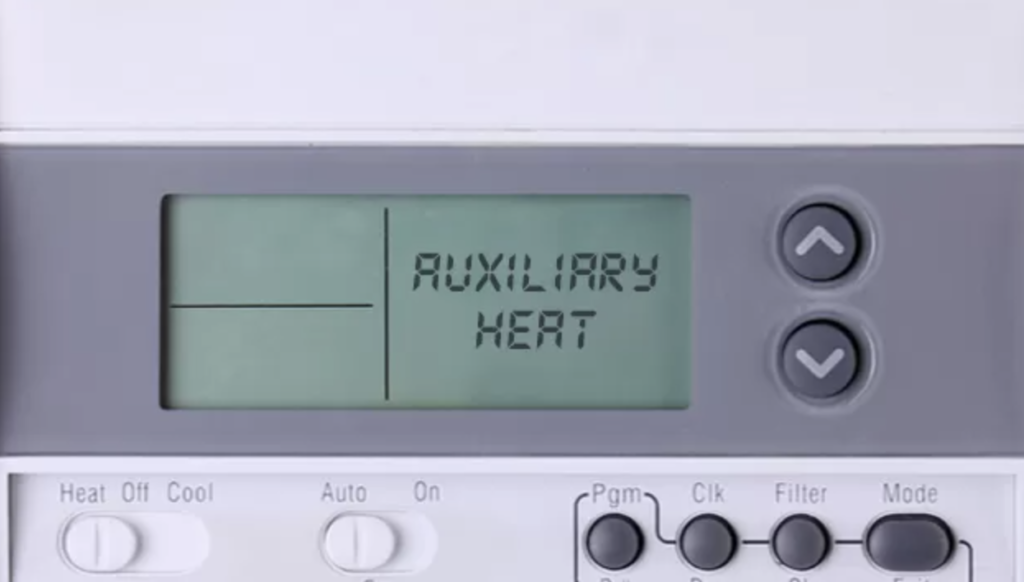Honeywell Thermostat Aux Heat Explained.
Honeywell Thermostat Aux Heat Honeywell functionality are designed to effectively manage heating systems featuring both a primary heating source and a secondary or backup heating source.
These thermostats are especially valuable in residences utilizing heat pump systems known for their exceptional energy efficiency but sometimes struggling to maintain comfortable indoor temperatures during exceptionally cold weather conditions.

The Honeywell Thermostat Aux Heat feature becomes particularly essential in these situations, ensuring reliable and efficient heating even in the most challenging cold spells.
Also read>>>HoneyWell Thermostat Blank Screen.
How it typically works:
- Primary Heat Source (Heat Pump): The heat pump itself serves as the main source of warmth in a heat pump system. Heat pumps are effective for the majority of the year, although they might lose effectiveness in severely cold temperatures.
- Secondary or Auxiliary Heat Source: The heat pump may have trouble drawing in enough heat from the outside air when the temperature drops significantly to sufficiently warm the house. The thermostat has the ability to turn on the backup heating system in certain circumstances. Frequently, a gas furnace or an electric resistance heating element is used for this.
- Thermostat Control: The automatic switching between the primary and auxiliary heat sources is managed by the Honeywell thermostat with auxiliary heat. To decide when to use each source, it keeps an eye on the temperature both inside and outside. The thermostat will request supplemental heat to support the heat pump if it is unable to maintain the appropriate temperature on its own.
The utilization of supplemental heat, facilitated by the Honeywell Thermostat Aux Heat feature, can lead to increased energy consumption and potentially higher operating costs compared to relying solely on the heat pump.
Consequently, the thermostat activates auxiliary heat only under specific conditions, such as extremely cold outdoor temperatures or when the heat pump enters defrost mode.
This innovative technology ensures that your heating system operates efficiently for the majority of the time, while also affording you the flexibility of a more robust heat source when necessary.
To optimize both energy efficiency and indoor comfort in your home, it is crucial to properly install and maintain your Honeywell Thermostat with Aux Heat
Types of Heating Systems where Auxiliary Heat are commonly used.
In the pursuit of maintaining comfortable indoor temperatures, especially during frigid conditions, heating systems, notably heat pump systems, often rely on auxiliary heat, with the Honeywell Thermostat Aux Heat feature being a key player in this process.
To fully appreciate the significance of auxiliary heat in such systems, it’s essential to delve into the various types of heating systems and their collaborative operation with auxiliary heat.
- Heat Pump Systems:
Because they move heat from one place to another rather than producing it, heat pump systems are very effective. A heat pump transfers heat from the exterior air (or, in the case of a geothermal heat pump, the ground) into the interior space during the heating season.
However, heat pumps lose some of their ability to remove heat as the outside temperature drops. Here is where supplemental heat is useful.
Also read>>>>Honeywell Thermostat connection failure.
Auxiliary Heat in Heat Pumps:
- Heat pumps come with a backup gas furnace or electric resistance heating coils as an auxiliary heat source. The thermostat turns on the auxiliary heat to help out when the heat pump is unable to provide enough heat on its own.
- The thermostat tracks the temperature inside and outside to decide when to turn on the auxiliary heat. For instance, supplementary heat may be required if the target indoor temperature is much greater than the existing interior temperature and it is extremely cold outside.
- Although it can swiftly increase indoor temperatures, auxiliary heat is less energy-efficient than a heat pump. Because of this, it’s often only employed when absolutely essential.
- Furnace Systems:
Furnaces produce heat by igniting fuel or heating components, whether they are fueled by gas, oil, or electricity. Furnaces are frequently the main source of heat in homes because they do not rely on heat transfer from the environment like heat pumps do.
Auxiliary Heat in Furnace Systems:
- While furnaces don’t typically have auxiliary heat sources like heat pumps, they may have backup generators or additional heating elements to provide supplemental heat in case of system malfunctions or extreme cold conditions.
- Boiler Systems:
Boilers heat water or use steam to distribute heat through radiators, baseboard heaters, or in-floor heating systems. They are commonly found in older homes and can be powered by various fuels, including natural gas, oil, and electricity.
Auxiliary Heat in Boiler Systems:
- Similar to furnaces, boilers primarily rely on the combustion of fuel or electric heating elements to produce heat. They may not have a specific auxiliary heat source but can have backup systems to maintain heating in case of boiler malfunctions.
Also read>>>>Rheem Air Conditioner Problems.
Benefits of Auxiliary Heat
Employing auxiliary heat within heating systems, especially during challenging conditions like extremely cold weather, brings forth a host of advantages that enhance heating efficiency and the overall comfort experienced within homes.
To gain a comprehensive understanding of the merits of utilizing auxiliary heat, it’s worthwhile delving further into the benefits afforded by the Honeywell Thermostat Aux Heat feature.
- Reliable Cold-Weather Heating:
The dependability of supplemental heat in extremely cold temperatures is one of its main advantages. When temperatures drop dramatically, heat pumps—which are extremely effective and environmentally friendly—may have trouble drawing in enough heat from the outside air.
When the heat pump’s performance declines, auxiliary heat offers a dependable source of warmth, keeping households warm even during extremely cold spells.
- Faster Heating Response:
Quick-heating auxiliary heat sources include electric resistance heating coils and gas furnaces.
The thermostat can turn on auxiliary heat to deliver a quick heating reaction when it notices a sizable temperature gap between the intended indoor temperature and the existing indoor temperature.
As a result, homeowners don’t have to wait very long for their houses to achieve the ideal temperature, increasing convenience and general comfort.
- Maintaining Constant Indoor Temperatures:
Homeowners can maintain more constant indoor temperatures throughout the year by employing supplemental heat when necessary.
Without supplemental heat, the heat pump can find it difficult to meet the demand for warmth in extremely cold weather, which could lead to temperature swings and potential discomfort.
In order to fill the gap and maintain a steady and cozy indoor atmosphere, auxiliary heat is used.
- Energy Efficiency Balance:
Although auxiliary heat works well to heat a house, it uses more energy than a heat pump, which is a primary source of heat.
Here, the advantage is that supplementary heat is only applied selectively, sparingly, and when absolutely necessary.
Homeowners may reduce their energy expenditures while still enjoying warm, comfortable indoor areas thanks to this balance between energy efficiency and heating efficacy.
- Enhanced Comfort and Peace of Mind:
Homeowners feel more at ease knowing that supplementary heat is accessible, especially in the chilly winter months.
It guarantees that the heating system can withstand even the worst weather, lowering the possibility of discomfort or frozen pipes as a result of inadequate heating.
- Customizable Control:
Homeowners can personalize the settings on contemporary thermostats with auxiliary heat capability.
They have the ability to adjust temperature differentials, when auxiliary heat is turned on, and even the integration of smart thermostats for remote control and energy efficiency.
Thermostat Control.
Honeywell Thermostats equipped with auxiliary (aux) heat capabilities are purposefully engineered to deliver precise control when transitioning between primary and auxiliary heat sources, thereby guaranteeing the highest levels of both comfort and energy efficiency.
In this comprehensive examination, we delve deeply into the mechanisms by which Honeywell Thermostat Aux Heat ensures the effective management of this vital function.
- Temperature Differential Control:
Advanced algorithms on Honeywell thermostats keep track of both indoor and outside temperatures. They use a function called “temperature differential control” to choose when to turn on supplementary heat.
- The thermostat allows users to set a temperature differential, which is the difference between the desired indoor temperature (setpoint) and the current indoor temperature. For example, if you set the thermostat to 70°F and the current indoor temperature is 65°F, the temperature differential would be 5°F.
- When the thermostat detects that the indoor temperature has fallen below the setpoint by the specified differential, it will initiate a call for heating. If it’s very cold outside and the primary heat source, such as a heat pump, cannot meet the heating demand on its own, the thermostat will activate the auxiliary heat source.
- Outdoor Temperature Sensing:
Some Honeywell thermostats include sensors that measure the outside temperature.
The thermostat can make better decisions about whether to activate auxiliary heat thanks to the additional data that these sensors give it.
- For instance, if the outdoor temperature is extremely cold, the thermostat may be more inclined to activate auxiliary heat earlier or for longer durations to ensure the indoor temperature remains comfortable.
- Balance Between Efficiency and Comfort:
Thermostats made by Honeywell are configured to balance comfort and energy economy.
Auxiliary heat can quickly increase the temperature inside a space, although it is less energy-efficient than a primary heat source.
As a result, the thermostat is made to only use auxiliary heat when absolutely essential in order to conserve energy.
- User-Defined Settings:
Homeowners can customize Honeywell thermostats to some extent. The temperature differential is one of the variables that users can change to suit their comfort preferences and energy-saving objectives.
Homeowners can fine-tune their heating systems to suit particular demands thanks to this versatility.
- Smart Thermostat Integration:
Numerous Honeywell thermostats are compatible with mobile apps and smart home devices.
With the help of this connection, customers can remotely monitor and manage their thermostats, ensuring that the heating system is functioning effectively and that supplementary heat is used only when necessary—even when they are away from their homes.
Also read>>>>Air conditioner Keeps tripping Breaker.
Efficiency Tips.
To strike a balance between creating a comfortable home environment and managing heating expenses effectively, homeowners need to harness the full potential of energy efficiency when making use of auxiliary heat, with the assistance of Honeywell Thermostat Aux Heat.
To assist homeowners in accomplishing this objective, we offer the following guidance and recommended practices:
- Set Temperature Differentials Wisely:
The temperature differential can be established on Honeywell thermostats that have aux heat capability, as was previously described.
Aim for a fair disparity that strikes a balance between efficiency and comfort.
The frequency of supplemental heat use will decrease with a higher differential, although larger temperature fluctuations might occur. Try several things to find the best balance for you.
- Regularly Maintain Your Heating System:
Make sure that the major and auxiliary heating elements of your heating system are all properly maintained.
To keep your HVAC system functioning properly, schedule regular inspections and cleanings. A system that has been well-maintained uses less energy to function.
- Seal and Insulate Your Home:
Your heating system’s workload can be greatly reduced with proper insulation and draft-sealing techniques.
Look for gaps around windows and doors, seal them, and, if necessary, add insulation. Additionally, insulating your walls and attic can significantly improve energy efficiency.
- Use a Programmable or Smart Thermostat:
If you haven’t already, think about switching to a programmable or smart thermostat.
You can program these thermostats to heat your home at specific times in accordance with your daily schedule.
In order to reduce the need for auxiliary heat during times of lower demand, you can configure them to lower the temperature when you’re away or sleeping and boost it when you’re at home and awake.
- Regularly Replace Air Filters:
Your heating system can become less effective due to airflow restrictions caused by dirty air filters.
To guarantee appropriate airflow and heating system effectiveness, check and replace your air filters frequently, usually every 1-3 months.
- Zone Heating:
Utilize the different heating zones in your house if you have them. Only heat the rooms in your house that are actually occupied; turn down or off the heat in any empty rooms.
Zone heating can lower your requirement for supplemental heat and help you conserve electricity.
- Consider Supplemental Heating Sources:
Consider employing additional heating sources, such as space heaters, in rooms of your house where you spend a lot of time, such as the living room.
This may enable you to retain comfort in regularly utilized areas while lowering the thermostat.
- Regularly Monitor and Adjust:
Watch your thermostat settings and your energy usage. Depending on the outside temperature and your preferred level of comfort, change the settings as necessary.
Smart thermostats frequently offer information on energy usage and recommendations for improvement.
Common Issues with Auxiliary Heat in Heating System.
Auxiliary heat in heating systems, including heat pumps, can encounter typical challenges that occasionally result in diminished efficiency or discomfort.
In such instances, homeowners can turn to Honeywell Thermostat Aux Heat for assistance in resolving these common issues.
Here, we outline prevalent problems and offer troubleshooting guidance to aid homeowners in effectively tackling these issues:
1.Auxiliary Heat Running Excessively:
Issue: If you notice that auxiliary heat runs continuously, it may indicate a problem with the primary heating source or thermostat settings.
Troubleshooting:
- Check the thermostat settings to ensure that the temperature differential is not set too high. Lowering the differential can prevent unnecessary auxiliary heat usage.
- Verify that the primary heating source (e.g., the heat pump) is operating correctly. If it’s malfunctioning or in defrost mode frequently, it may trigger auxiliary heat more often.
- Inspect and clean the outdoor unit of the heat pump. Ice or debris buildup can reduce its efficiency.
2.Inadequate Heating in Cold Weather:
Issue: If your home isn’t reaching the desired temperature during extremely cold weather, it may indicate that the auxiliary heat isn’t activating when needed.
Troubleshooting:
- Check the thermostat’s outdoor temperature sensor if available. Ensure it’s properly installed and functioning. If not, consider installing one to improve the thermostat’s decision-making process regarding auxiliary heat.
- Lower the temperature setting on your thermostat slightly to encourage the heat pump to operate more frequently. This can help maintain efficiency.
- Ensure that the heat pump is appropriately sized for your home. An undersized heat pump may rely on auxiliary heat excessively.
3.Thermostat Malfunction:
Issue: Thermostat issues can lead to incorrect control of auxiliary heat or no heat at all.
Troubleshooting:
- Check the thermostat’s display for error messages or unusual behavior. If there’s a problem with the thermostat itself, consider replacing it or contacting a professional for repairs.
- Verify that the thermostat is wired correctly. Incorrect wiring can lead to improper control of the heating system.
4.High Energy Bills:
Issue: If your energy bills are unexpectedly high, it could be related to auxiliary heat usage.
Troubleshooting:
- Review your thermostat settings and habits. Ensure that you’re not keeping the temperature significantly higher than necessary.
- Consider scheduling an HVAC maintenance checkup to ensure that your heating system, including the auxiliary heat source, is operating efficiently.
- If your home lacks proper insulation or has drafty areas, addressing these issues can help reduce the need for auxiliary heat and lower energy bills.
Also read>>>Aux Heat on but no Heat.
5.Inconsistent Temperature Throughout the Home:
Issue: Uneven heating can be a problem, especially in larger homes or those with multiple zones.
Troubleshooting:
- Verify that your heating system is balanced correctly for zoned systems. Adjust the dampers or zone valves to distribute heat more evenly.
- If using supplemental heating sources (e.g., space heaters), ensure they are distributed strategically to address cold spots.
Conclusion.
In conclusion, Honeywell thermostats that can operate with auxiliary heat are an essential component of contemporary heating systems because they give homeowners better control, comfort, and energy savings.
We’ve discussed the numerous aspects of auxiliary heat, its significance in heating systems like heat pumps, and the advanced features Honeywell thermostats offer for effective regulation.
Honeywell Thermostat Aux Heat plays a pivotal role in ensuring consistent and reliable heating performance, particularly during extremely cold weather, and is often employed alongside primary heating sources such as heat pumps.
It serves as a valuable backup, swiftly responding to temperature fluctuations and maintaining a steady indoor climate when the primary heat source faces limitations.
Achieving this equilibrium between comfort and efficiency is paramount for households seeking dependable and cost-effective heating solutions.
Additionally, we discussed typical auxiliary heat difficulties and offered troubleshooting tips to assist homeowners in resolving issues and maintaining effective heating systems.
Honeywell thermostats with auxiliary heat control provide a complete solution in a society where comfort and energy economy are crucial.
They not only make sure your house stays warm and comfortable, but they also provide you the power to do so in a way that is both economical and environmentally friendly.
With cutting-edge, simple-to-use solutions to satisfy the many needs of homeowners in the dynamic world of home heating, Honeywell continues to be at the forefront of technology.









